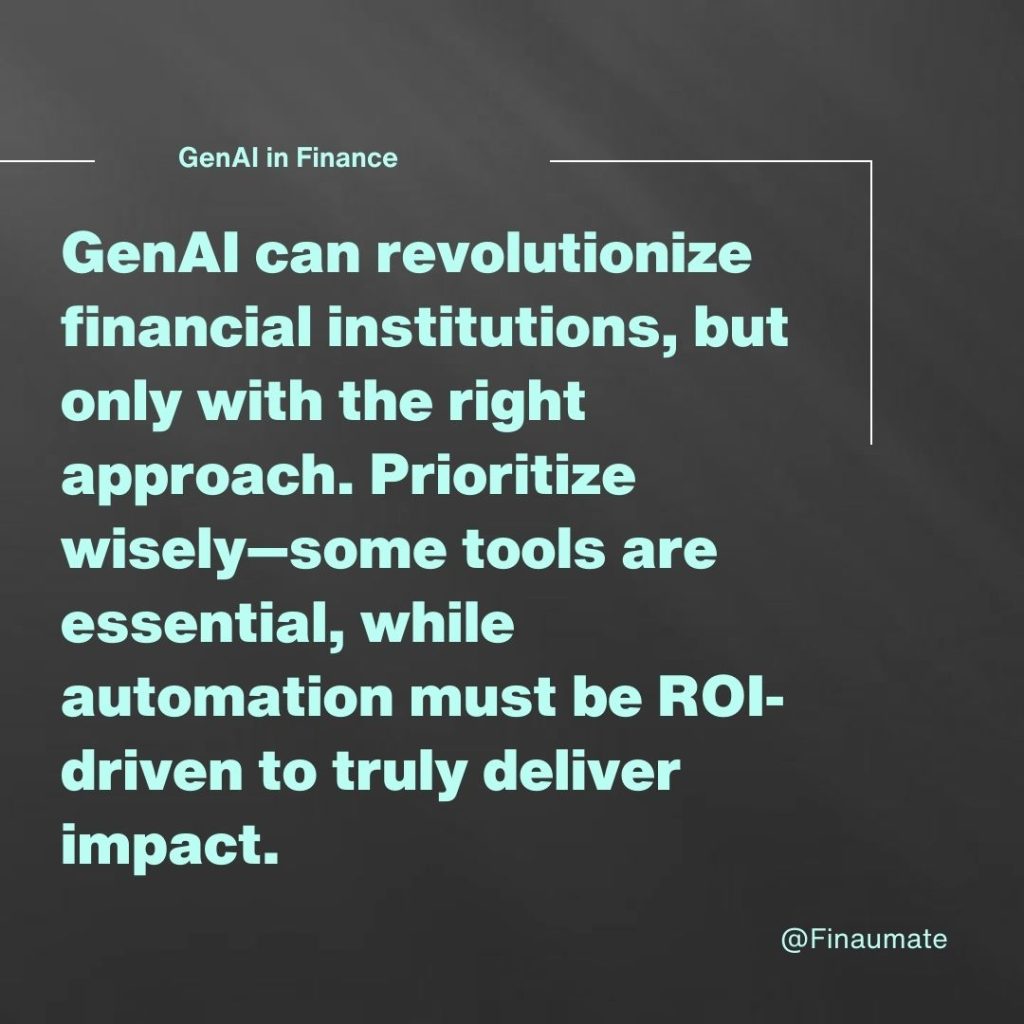Financial institutions invest heavily in large-scale digitization GenAI initiatives and programs to increase productivity and efficiency. However, without a strategic approach, these initiatives risk the same pitfalls that have plagued past digitization efforts.
Key takeaways of this article:
- Not all AI initiatives should be measured by ROI – essential productivity tools must be prioritized based on necessity rather than financial return.
- Process automation should follow a structured feasibility and ROI-driven approach, ensuring the right processes are selected for automation.
- Cross-functional expertise is crucial – successful AI adoption requires collaboration between Process Owners, AI experts, infrastructure specialists, and compliance teams.
The Pitfalls of Large-Scale Digitization in Financial Institutions
Financial institutions frequently launch large-scale digitization programs to enhance productivity and efficiency. Yet, many of these initiatives fall short of expectations, with hundreds of millions spent and little to show for it. Generally, over 70% of digital transformations exceed their initial budgets, studies reveal, with some projects costing more than double the original projections (McKinsey). Common reasons for these failures include:
- Overinflated internal budgets: Institutional budgets can be exaggerated, leading to inefficient spending.
- Misallocated resources: Hiring unnecessarily large teams composed of the wrong people to consume allocated funds.
- Rushed expenditures: Budgets that must be spent within strict timelines, leading to poor investment decisions.
- Top-down pressure: Initiatives launched by senior management for internal and external publicity without adequate preparation.
- Premature termination: Programs end due to budget cuts before delivering results.
- Bureaucratic red tape: Institutional complexity often slows down or entirely halts progress.
Large tech transformations typically experience significant cost overruns and delays, according to a global analysis,, underscoring the need for effective planning and execution.

GenAI is reshaping finance and banking – don’t get left behind. Our exclusive newsletter delivers insights you simply can’t afford to ignore. Subscribe HERE.
The Growing Focus on AI in Financial Institutions
Today, nearly every financial institution has either launched or is about to launch a new AI initiative. However, without a structured approach, these projects risk falling into the same traps as previous digitization efforts.
There is increasing discourse on ROI-driven initiatives and how to use ROI as a criterion for selecting AI projects. This article explores how financial institutions can effectively identify the right AI initiatives and allocate appropriate budgets and resources at the top level.
Understanding the AI Landscape: Traditional Machine Learning vs. GenAI Initiatives
AI in financial institutions generally falls into two categories:
- Traditional Machine Learning (ML):
- Most large financial institutions have already integrated ML into past digitization programs.
- Core ML applications such as fraud detection, risk assessment, and predictive analytics should already be established.
- Further investment in ML should be incremental rather than a completely new initiative.
- Generative AI (GenAI):
- GenAI presents new opportunities for automation and innovation.
- The focus should be on leveraging GenAI for areas where existing digital solutions are insufficient or entirely absent.
This article will focus on GenAI initiatives, which represent the next frontier of AI-driven efficiency in financial institutions. In our past article we explained that GenAI deployment has 2 different streams.
The Two Key Streams of GenAI Initiatives Deployment
1. Desktop Productivity Tools
This category includes AI assistants, desktop automation tools, document Q&A solutions, and AI-enhanced web search capabilities. These tools are essential for improving individual and team productivity.
Why Productivity Tools Should Not Be ROI-Driven when Adapting GenAI Initiatives
- Their impact is qualitative rather than quantitative, making it difficult to measure ROI in traditional terms.
- Like search engines (e.g., Google), these tools become indispensable once integrated into daily workflows.
- The key decision for institutions is whether to buy these solutions as a service or develop in-house versions, depending on data restrictions.
- Actionable Step: Identify necessary tools, allocate budgets, and execute implementation without expecting direct ROI measurements.
2. Process Automation
GenAI initiatives can significantly enhance operational efficiency by automating manual processes. Institutions must take a structured approach to determine which processes to automate:
Step 1: Identify Manual Processes
- Large institutions maintain a process universe (typically managed by the COO team) with designated Process Owners.
- Each Process Owner should provide a list of manual processes they oversee, detailing:
- The number of man-days (MD) spent on each process.
- The frequency of execution.
- The average cost per MD.
Step 2: Assess Feasibility of GenAI Initiatives
After documenting all manual processes and their costs, an evaluation team (including Process Owners, AI experts, infrastructure specialists, and compliance teams) must assess:
- Data Accessibility: Can the required data be accessed without compliance or infrastructure roadblocks?
- Data Usability: Is the data in a format suitable for GenAI, or can it be adapted within a reasonable timeframe?
- Infrastructure Readiness: Are the necessary computing resources available, or can they be implemented efficiently?
- Technology Feasibility: Is GenAI mature enough to automate the process effectively?
If all these factors are favorable, the next step is to calculate potential time and cost savings against the required investment.
Step 3: Apply ROI-Based Prioritization
Financial institutions can prioritize automation projects based on ROI potential by aggregating the cost of each manual process, expected savings, and necessary investment.
Key Consideration:
- To realize cost savings, redundant staff must be retrained, reallocated, or let go. Institutions should proactively address these workforce implications before initiating automation efforts.
Learning from Industry Examples
Several financial institutions have successfully integrated GenAI initiatives to enhance operations:
- Schroders: Implemented an AI tool that reduced document translation times by 80%, significantly improving efficiency (Financial News).
- Morgan Stanley: Deployed a generative AI application to summarize video meetings and draft follow-up emails, streamlining internal communications (Wall Street Journal).
These examples illustrate the tangible benefits of well-executed GenAI initiatives in the financial sector.
Summary and Best Practices
- Desktop Productivity Tools: Essential for efficiency but should not be evaluated based on ROI.
- Process Automation: Requires a bottom-up approach, starting with identifying manual processes and prioritizing them based on feasibility and ROI.
- Cross-Functional Expertise: The evaluation team should include Process Owners, AI experts, infrastructure specialists, and compliance teams to ensure successful implementation.
Contact Us To Discuss Your Digitization Initiatives Efforts
Financial institutions must adopt a structured, ROI-conscious approach to GenAI initiatives to maximize success and avoid common pitfalls. We have the expertise to guide you through this process. Contact us today to ensure your GenAI projects are strategically selected and effectively executed.







